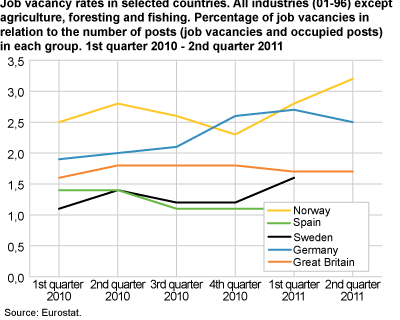Content
Published:
This is an archived release.
Growth in job vacancies
There were 78 000 job vacancies in the 2nd quarter of 2011. This is a growth of 10 500 from the same quarter last year. The majority of the growth took place in the private sector.
Of all the major industry divisions, the growth of job vacancies was largest in the administrative and support service activities, with 3 200.The major industries accommodation and food service activities and domestic trade both had a growth of 1 600. The changes in the growth rate varied more in major industries where the public sector is dominant. The major industries public administration and education had a decline of 800 and 900 respectively, while the major industries human health services, residential care activities and social work without accommodation grew by 2 000.
Most job vacancies in administrative and support service activities
With regard to the number of job vacancies, the administrative and support service activities was the largest major industry in the 2nd quarter of 2011, with 10 700. Then followed residential care activities with 8 400 and domestic trade with 8 300 job vacancies. The major industries with the largest number of employees generally have the largest number of job vacancies. However, in times when the economy is rising, an industry will tend to have more job vacancies. Concerning the 2nd quarter of 2011, many major industries need holiday stand-ins.
Vacant job - definitionThe vacancy must be announced, formally or informally. Formal announcements include, for example, advertisements in newspapers, on the Internet, notifying the public employment services or private employment agencies. Informal announcements include, for example, advertisements in shop windows or public notice boards, or announcements via employees, friends or family. Job vacancies exclusively open to internal applicants (within the enterprise, organisation or corporation) are not included in this definition of job vacancies. The post must be paid. Rate of job vacancy - definitionThe number of job vacancies as a percentage of the number of employees + the number of job vacancies. |
A percentage growth of job vacancies up to 3.2
All major industries together had a growth rate of 0.4 per cent, up to 3.2 per cent from the 2nd quarter of 2010 to the 2nd quarter of 2011. The rate of job vacancies was 7.8 per cent in administrative and support service activities, which is a growth of 2.2 percentage points from the previous year. Other industries with a large rate of job vacancies were residential care activities with 6.0 per cent and accommodation and food service activities with 4.9 per cent. Professional, scientific and technical activities and information and communication both had a rate of 4.0 per cent job vacancies. In the major industries of agriculture, forestry and fishing and transport and storage the rate of job vacancies was low; 1.7 and 1.5 per cent respectively. In these two major industries the rate has been low during all six quarters that Statistics Norway has published statistics of job vacancies.
Norway had the largest percentage of job vacancies in Europe
Among the countries in the EU/EEA area, Norway had the largest rate of job vacancies; 2.8 per cent in the 1st quarter of 2011. We have made the comparison with other countries based on the 1st quarter of 2011, as the 2nd quarter figures are not yet published.
Germany and Finland both had a rate of 2.7 per cent. Sweden had a rate of 1.6 per cent. Agriculture, forestry and fishing are excluded from this international comparison. For more information is available on Eurostat’s website .
Tables:
Contact
-
Arbeidsmarked og lønn
E-mail: arbeidsmarked@ssb.no
-
Rakel Gading
E-mail: rakel.gading@ssb.no
tel.: (+47) 40 81 14 75
-
Jan Sebastian Rothe
E-mail: jan.rothe@ssb.no
tel.: (+47) 91 31 99 06

